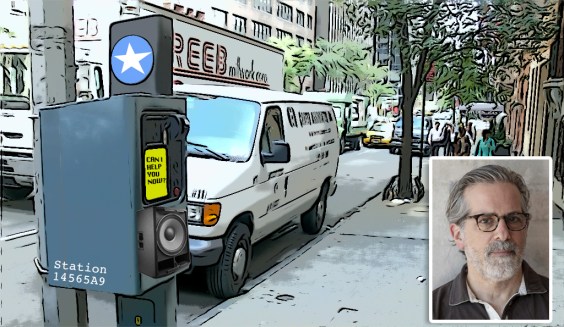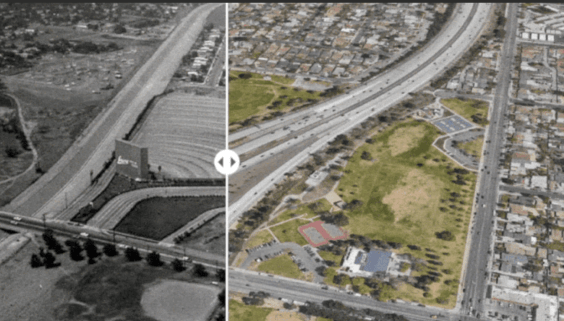Editor's note: Today we begin Part I of our occasional series on LOS reform.
 Traffic engineers are reluctant to give exclusive lanes to buses (or bikes) for fear of the impact on cars
Traffic engineers are reluctant to give exclusive lanes to buses (or bikes) for fear of the impact on carsThe Pseudo-Science of LOS
There's a dirty little secret you should know about San Francisco: It's engineered first and foremost for automobility and will never be able to shed this bias if the traffic engineers are in the driver's seat wielding their traffic analysis tools like bibles. As long as the city continues prioritizing the use of transportation analysis known as Level of Service (LOS), you might as well burn our Transit First policy for warmth.
On the one hand, LOS is a very simple and blunt metric for understanding the speed that vehicles can move about the city. LOS measures the amount of vehicular delay at an intersection, with A through F grades assigned to increased delay. This measurement is taken during the peak 15 minutes of evening rush hour and if an intersection slips from LOS D to LOS E, traffic managers will try to mitigate the impact, which usually means widening the road, shrinking the sidewalks, removing crosswalks, softening turning angles, and adjusting signal timing to speed the movement of vehicles.
 LOS delay from Highway Capacity Manual
LOS delay from Highway Capacity ManualLOS analysis seems like science, free from political or ideological considerations, the perfect traffic-engineering tool to rationalize our cities, but the methodology behind it is far from precise. As Jason Henderson, professor of geography at San Francisco State University, said at a recent presentation, LOS is a very poor tool methodologically. In the early years of its development, the "science" was merely traffic engineers assuming what made motorists uncomfortable. He cited the fact that LOS F used to represent a delay of more than 60 seconds, but that in the 2000 Highway Capacity Manual it was revised to 80 seconds. And motorist behavior studies since have shown that inconvenience with delay can depend on numerous factors and differ dramatically between drivers.
Yet the result of relying on this poor methodology to shape the growth of cities has a profound affect on the politics of human mobility, privileging the movement of vehicles before the movement of anything else. Quite simply, LOS analysis has given us Phoenix and Atlanta, congestion and ever-longer commutes, and a whole host of ills that accompany reliance on the inefficient use of street space for our cars.
"I've been doing transit analyses in California for 20 years," said Jeffrey Tumlin, principal of Nelson Nygaard, a transportation and land use consulting firm. "In my practice the single greatest promoter of sprawl and the single greatest obstacle to transit oriented development (TOD) and infill development is the transportation analysis conventions under CEQA, the California Environmental Quality Act, LOS."
LOS has been used since the middle of the 20th century and has the weight of convention so thoroughly backing it up that it is one of the Traffic Ten Commandments, somewhere near the top. When the U.S. prioritized the expansion of roads everywhere and cities were seen merely as job centers to be driven to and from, LOS was the lubricant to facilitate the growth of suburban and exurban rings.
As San Franciscans began to see their city as a collection of neighborhoods, where livability and public space were more important that vehicle speeds on the streets, the political support for unfettered automobility declined and LOS became a target for reform.
"How can LOS have such a tremendous impact or power over shaping San Francisco and shaping cities when so much of LOS is anathema to cities?" asked Henderson.
The Clamor For Change
In the early 1990s, San Francisco bicycle advocates found out the hard way that any attempt to take space away from cars to give back to bikes (or transit and pedestrians) would be shut down by the engineers who asserted that such constriction of vehicular access violated the sacrosanct LOS rules, which, they were informed, were required under CEQA.
The advocates soon discovered that while CEQA requires that a project be analyzed for its significant environmental impacts the LOS "rule" was written after the fact by the state Office of Planning and Research (OPR). It was an administrative guideline and didn't carry the force of CEQA law.
"The words 'traffic' or 'congestion' or 'parking' appear nowhere in the CEQA legislation of the 1970s," said Tumlin. "The
problem lies in the CEQA guidelines, issued administratively by the state OPR. There are three lines in Appendix G, the environmental
checklist...[that] were later adopted administratively by the executive branch of government."
Further, CEQA specifically delegates planning decisions to the local level.
The adherence to LOS was a convention adopted by San Francisco and most other municipalities around the state to evaluate transportation impacts under CEQA, and over the course of nearly three decades its use had been upheld numerous times in court, but just as it had been adopted as a convention, advocates believed, so could it be overturned.
Subsequently, advocates spent years lobbying the Board of Supervisors to make changes to the rule, though with mixed results. After the board finally called for a study of the impacts of LOS analysis, the San Francisco County Transportation Authority (TA) issued a significant report (PDF) at the end of 2003, which asserted that "existing LOS measures and standards ostensibly favor preserving auto level of service at the expense of improving transit, bicycle, and pedestrian conditions" and argued that new measures of analysis besides LOS should be developed.
Within a couple years the Board of Supervisors was convinced that LOS analysis contravened San Francisco's Transit First policy and issued a resolution (PDF) stating that "automobile analysis alone is not an appropriate metric for assessing environmental impacts and for analyzing projects that may improve overall environmental quality in conformance with [the Transit First policy]."
Not long after the resolution was adopted in early 2006, advocates saw firsthand how low the interpretation of LOS could stoop, when Rob Anderson and his Coalition for Adequate Review (CAR, a suitable acronym) sued the city to prevent the Bicycle Plan from being implemented without the full environmental review process, banking his argument on the possible negative LOS implications of removing vehicle lanes to add bicycle lanes.
Though it might have seemed ludicrous to the lay observer that adding bike lanes would have a negative environmental impact, the rules of LOS dictated that it was so and the onus was on the city and the bicycle community to show in excruciating--and expensive--detail that promoting non-polluting transportation might significantly effect the environment. But that's exactly what the injunction mandated and why San Francisco hasn't added even a brush stroke of paint to its roads to build out its bicycle plan for nearly three years.
Paradise LOSt (Part II): Turning Automobility on Its Head
Paradise LOSt (Part III): California's Revolutionary Plan to Overhaul Transportation Analysis
Flickr photo: cbcastro





